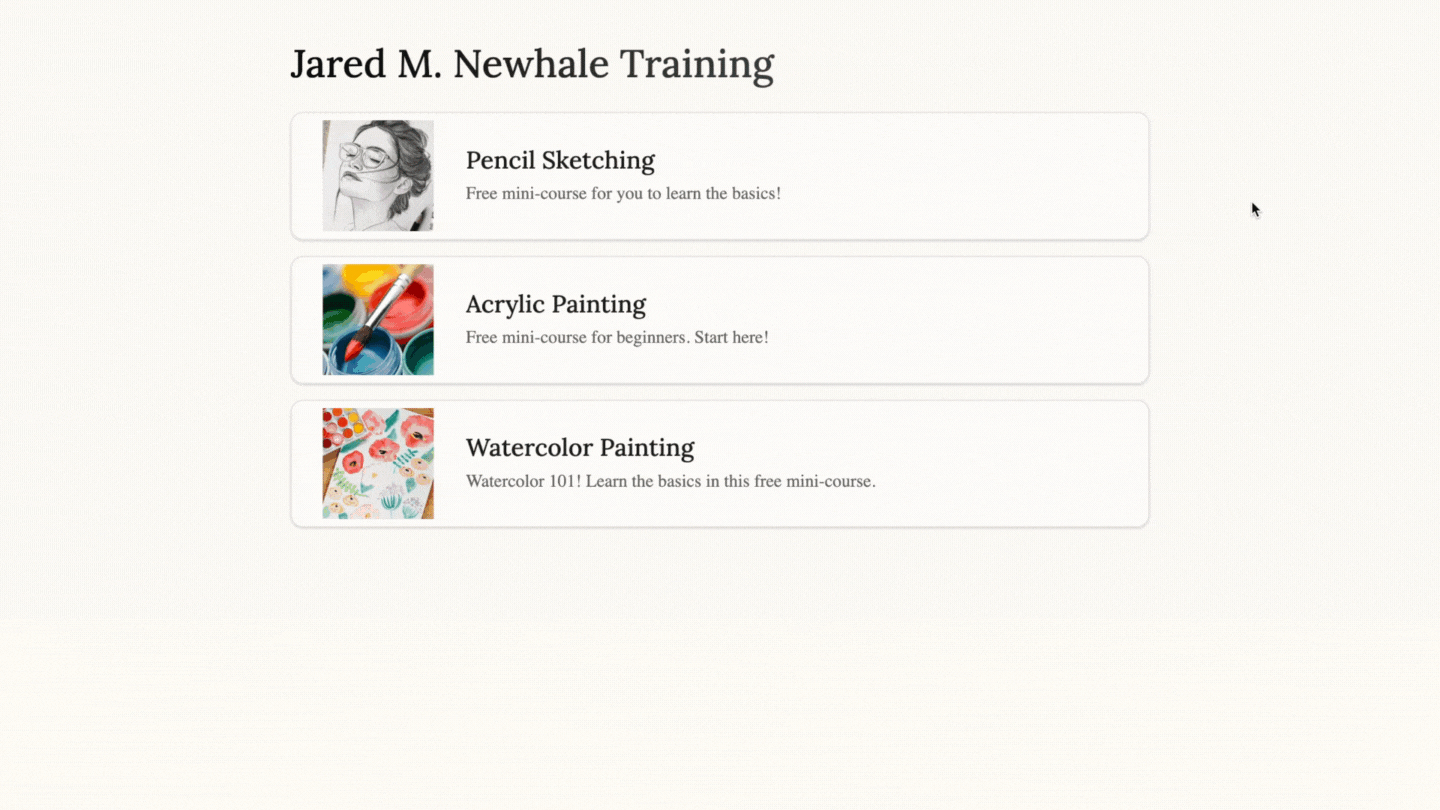One of the most effective ways to keep people engaged with your business is through educational content. Especially if you are an online course/workshop provider, trainer, or actively in coaching business, presenting educational content is a common practice, and it works very well as a lead magnet! When you offer a portion of your knowledge, you actually make it your marketing power. When you can provide relevant, interesting information that benefits your audience’s lives, they are more likely to stay connected and grow their relationship with you. By breaking down complex concepts into small chunks, it becomes easier to digest and retain information. If done correctly, these bite-sized lessons will boost engagement levels by keeping the audience interested in learning more about your products and services. Creating mini-courses is a wonderful way of putting your expertise into action easily and quickly. Mini-courses are very effective lead magnets and they are also useful and easy-to-use tools for lead nurturing.
If you ever wonder why and how to start creating your first mini-course; the following listicle gives example of 11 creative ways how mini courses in general and how minicoursegenerator.com specifically can contribute to your business.
Outline
- Using mini-courses as lead magnets
- Testing mini course ideas
- Getting financial support
- Using in email newsletters and blog posts
- Understanding your audience
- Using for post-training follow-up
- Create instructional resources
- Offering multiple free preview paths
- Embedding in a webpage
- Warming up before training events
- Getting closer to the potential customers
Let’s start!
- Use mini-courses as lead magnets to grow your list
Offering free and high-value content in exchange for user’s email addresses is a common practice. Provide something substantial like a mini-course, free ebook or article series that people will see value in – they’ll be more likely to sign up for your newsletter without any hesitation.
By using interactive mini-courses, you can create more engagement from your freebies than with other content options. The key difference of a mini-course from PDFs, preview videos, etc. is that, it provides two-way communication. You can get inputs from your leads, ask questions and let them engage with your work. Thus, convert them from cold visitors to actual audience by interaction. Besides, thanks to the videos and different types of questions that you can use in your high-value content, a mini-course becomes much less overwhelming when compared against pdfs or written text only formats.
A mini-course has this power of interactivity. It creates a sense of achievement and willingness to commit something bigger among your audience. Hence, lead generation becomes more effective! You can generate leads for your online classes in a simple way. For example, if you are active on email marketing, you want to grow your mailing list with people who are actually interested in your business and you must be sick of dead emails or high unsubscribe rates. A mini-course will help you there, too! How? Check out our blog post.
- Test your mini course ideas to find attention grabbing topics
Do you have a course idea but are not sure if it will be successful? Wondering what topics to focus on or how to make your courses more appealing? You can decrease the risk of investing into a not-so-demanded course and increase the long-term potential gain by deciding on the right topic to focus on. Just make a mini version of your course as a start!
Getting started with that is easier than you’d ever think! Thanks to the simple structure and the AI-Assistant available at Mini Course Generator, content creation is fast. Like, in minutes! Once you get started and create a skeleton of the course, the rest will easily go with the flow. If you wonder how AI works at MCG, see the video below!
The importance of finding an idea that will engage your audience is crucial to success. Instead of a risky time investment, first start making experiments with your course ideas through different mini-course topics and see which one grabs the attention of your ideal reader, then focus on building content around this topic.

Besides that, we have already mentioned that you can use your mini-courses as previews to sell bigger offers easier. If you offer many programs on various subjects, and about to make an offer to your audience, how will you know in which program your audience will be interested more? Don’t try to answer this question, just present them a menu!
You can prepare their corresponding mini-courses for each subject you offer, and gather them together in a collection! Instead of individual mini-courses, you can share or embed this collection. Mini-course collections are wonderful to present your work in an organized way, with an index set by you.

The good part about collections is, users do not leave the collection page while experiencing your content and jumping in between different mini-courses. Let them choose what works best for them and proceed in that funnel.
For more ways to use collections, see our blog post!
- Get paid for sharing your know-how without building a macro-course
The concept of monetizing creator-produced online content isn’t new. Notably, Patreon has been around since 2013, or Teachable since 2014. Many social platforms including Instagram, YouTube and Twitter have already introduced subscriptions. On top of that, the world has completely changed in the past few years due to the pandemic and the social / economical events related to it. New business ideas based on remote-work concept emerged and many tools have developed to encourage and support online creators to produce their work.
If you want to sell your know-how with macro-course builders, there are many great products like Kajabi, Thinkific, Teachable. There are also many market place platforms like Udemy, Skillshare, Domestika, etc. to create and sell your own courses and earn a residual income. Yet even preparing ” a mini-course” on such platforms comes with a learning curve and fraction. Instead of making big time investments, you can start to get payments with your mini-courses while you work on your macro-course.
Our motto here is, start small and fast! You are good at what you do. Turn it into a mini-course with ease and speed. Mini Course Generator has direct integration with Stripe. So, you can charge for your mini-course, partially or wholly. Except Stripe’s own commission, you can earn from your mini-courses with no extra cuts from our side. If you are interested, read further here.
- Enrich email newsletters and blog posts with mini-courses
If you are a content creator, you probably work hard to present high-quality content since it is what keeps your readers engaged and interested in what you offer. You know the importance of lead nurturing more than anyone else! What if we told you, you can improve the audience engagement with adding a mini-course link inside an email newsletter or a blog post, which can improve the content depth. A mini-course can contain many videos, GIFs, images, and even PDFs without increasing the mail size. You can also add quiz questions to make your subscribers feel engaged and increase curiosity.
You might think that it will take extra time to prepare a mini-course, but as the name suggests, it can be pretty short, which may contain only 7-9 bite-sized content pieces. Your content, when presented in a mini-course format, will be more easy-to-read than just the text alone.
There are various content items available in Mini Course Generator including surveys, ratings, and short answer inputs. Blend them according to your unique needs! Here is a detailed article about what we offer.

- Understand your audience and improve your marketing communication
Who are your potential customers and how can you improve your lead acquisition strategy in the future? How much do they know about the topics you are teaching? What are they interested in most? What do they expect to see in your training? and so on… Asking these questions helps you understand your leads better which will improve your overall marketing investments. While answering these questions, you can list your hypothesis in the start, but you can verify them only by action and with real life examples. You can improve your findings only with the input you get from your audience.
When you can present your mini-course with an assessment, a survey, and feedback questions, you grasp the opportunity to get closer to your community and make more robust decisions about which areas you should spend more of your time and energy on. Understanding your customer is the holy grail of marketing, and why would you not take advantage of that especially with the free mini-courses you provide? Not only do you get new-sign-ups, but also you can collect data about your market.
Besides, we all know that personalized and targeted communication is the key for user acquisition. So, why not learn more about who you are talking to?
You can determine the knowledge level of a visitor by making quizzes directly on your landing pages with your mini-courses. Then, you can display conditional messages based on score and lead them to relevant offers. Result? Higher conversion!
- Increase knowledge retention with post-training follow-up
So far, we have talked about engaging with cold visitors and leads. But the functionality of mini-courses doesn’t end there! You can use your micro-learning journeys on nearly every step of the customer success pyramid, including the reinforcement activities about what you have already sold.
Adults forget fast. A lack of training reinforcement following a professional and technical training results in a waste of time and resources spent for the learning activity. To increase knowledge retention in your audience, you should benefit from the power of repetition. Ebbinghaus Forgetting Curve shows how knowledge retention decreases unless there are opportunities for reinforcement or practice, following initial professional and technical instruction.
By preparing mini-courses with question-rich content and bite sized reminders, you can increase the effectiveness of the training event. Additionally, training follow-up is not only helpful for retaining knowledge but also helps your business.You can build a stronger connection with your audience that will help in building future opportunities, like cross-selling or upselling new courses when they are ready.

Moreover, when you use your mini-courses post-training, you have the chance to cross-promote different programs! After all, in most cases it is easier to sell a second offer than making the first sell.
Add attractive CTA (call-to-action) link buttons at the end of your mini-course to lead your clients to another program you offer.
- Create instructional resources for customer success, community sharing, etc.
Customer success teams are an integral part of any business’ long-term success. They’re responsible for ensuring that customers have the resources they need to succeed, whether it’s through product knowledge or community engagement. The more customer-success-professionals create instructional content and share their insights with their communities, the more successful your brand will be.
Here, it is important to keep the communication two-sided! You cannot understand your customers fully if you are the only one speaking. Thus, it will be wonderful if you collected inputs from your customers to figure out use cases and also adjust your communication style accordingly.
For example, instructional content that is mainly based on tutorial videos can be also enriched with feedback questions like “Is this content helpful?”, “How can we improve this tutorial?”, “What do you want to see in the next step?”. The answers will help you create more optimized and effective tutorials for your customers’ needs – which means higher retention rates as well as community engagement.
- Offer multiple free mini-courses instead of one to sell more of your macro-course
It is a common practice to offer free content (e.g. preview videos) – to give your customers an idea about the course that you are selling. Yet the problem with such an approach is one size does not fit all. Visitors might have landed to your website with different needs and motivations and evaluate your course offer from different perspectives. So here comes the question: why do you limit yourself with a single path of free preview videos?
If you want to sell more of your macro-course, offer a few free mini courses. This allows the customer to try out different aspects of your training before committing to buy. It also helps them gain confidence that they can actually do what is advertised in the course before they spend any money on it.

- Increase engagement with your webpage by embedding mini-courses
Each webpage has a goal – to make a visitor pursue an action, like signing up for a newsletter, scheduling a cold call, contributing to a community, etc. The way ahead for increasing page conversion is providing better and more engaging content. This kind of engagement additionally increases SEO-performance since the more time a visitor spends on your webpage the higher your page will rank in Search Engine Results Pages (SERPs).
In order to increase the duration and the quality of the time a visitor spends on your website, your landing page should be attractive, engaging and convincing. So, how to build more attractive and SEO-friendly webpages?
You can embed your mini-courses with ease in any webpage you prefer. It’s the perfect way to provide interactive content that includes questions as well as motivational videos. Embedding to any webpage doesn’t require coding knowledge. It is a very easy and effective way to increase the performance of a website.
Besides, if you use WordPress, embedding is even easier with Mini Course Generator’s WordPress Plug-In. Watch the video below to see how it’s done!
- Warm up your audience before training events to increase show-up rate
Training professionals know that it is important to warm up and motivate an audience before a training event begins. As known, pre-event marketing leads to great training events. This is especially valid if you are offering your live training event for free to gain new leads.
You can place the link of your engaging mini-course on the event’s webpage or simply embed it directly on the landing page to start creating engagement days before the start of the event, to get more registrations, and to increase show-up rate. For these specific mini-courses to be used for pre-event marketing, use motivational content and question challenges to create curiosity, raise interest, and make attendees better understand how the event will contribute to their knowledge gain.
Besides, if you have several events on your schedule, building a mini course template first, and then customizing it according to a specific event saves you a lot of time and lets you focus on other work.
If you are interested in more possible ways of using mini-courses for live training events, please check our other blog post, which is about “How to improve marketing success of training events without extra spending for paid-marketing“

- Build stronger relationships with your customers through question-rich mini-courses
If you are in a consultancy or coaching business, you have probably experienced that it isn’t easy to convince people to slow down, think more, and spend time gathering and weighing evidence before deciding to take out their wallets and commit to a purchase. Yet, things become much easier when you can build a relationship with your customers.
We can create better connections and become more likable in the eyes of others by asking questions – as long as they’re the right type of questions, asked in the right way. Our success in connecting with others can be improved dramatically by asking more questions of the people with whom we’re trying to relate.
When you are preparing mini-courses for your consultancy or coaching business, include single- or multiple-choice survey questions, 1-5 likert scale questions, or free-text questions. When you know what each lead is looking for, it gets easier to draw them into the sales funnel and explain how you can satisfy their needs in what way.
It’s your turn now. How do you use mini-courses?
As mentioned in this article, there are many ways for creative facilitation of a minicourse and, sky is the limit. Any professional working in a client oriented business can benefit from mini-courses, especially online course creators, coaches and training providers. Please feel free to get in touch if you want to add a new use-case, have any questions for your specific use case or if we can help with anything! → [email protected]. If you want to know how to create a mini-course, simply get started with either signing-up or signing-in. Mini Course Generator is the simplest way to create mini courses in a very shırt time, and it’s a free tool for creating online courses.
